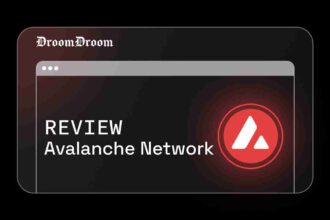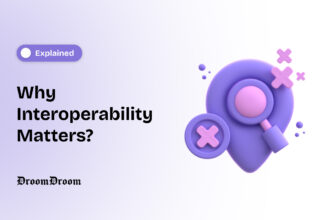The crucial decision you make in the web3 space is to find the best blockchain and choosing between Solana vs Ethereum can be difficult considering each has its own pros and cons. Solana and Ethereum are two of the most widely known blockchains. The blockchains are often compared to one another but how do they actually differ from one another?
- Solana Vs Ethereum: Choosing the Right Blockchain Platform
- What Is Solana?
- What Is Ethereum?
- Solana vs Ethereum: Comparing Different Criteria
- The Detailed Breakdown of Solana Blockchain
- Consensus Mechanism
- Tower Byzantine Fault Tolerance (BFT)
- Turbine
- Gulf Stream
- Sealevel
- Pipelining
- Cloudbreak
- One Last Thing About Solana: SOL Token
- The Detailed Breakdown of Ethereum Blockchain
- Consensus Mechanism
- Nodes and Clients
- Smart Contracts
- Ethereum Virutal Machine (EVM)
- Ethereum Accounts
- One Last Thing About Ethereum: Ether (ETH) Token
- Conclusion
Solana is a blockchain network founded by Raj Gokal and Anatoly Yakovenko claiming to be able to process a maximum of 65,000 tps with the average cost per transaction of $0.00025. On the other hand, Ethereum, first proposed by Vitalik Buterin introduced the world of web3 enthusiasts to smart contracts and decentralized applications (DApps).
In this article you can expect to read about – Solana vs Ethereum, Consensus Mechanisms like Proof of History (PoH) in the context of Solana, Proof of Stake (PoS) in the context of Ethereum, unique features of each blockchain including the difference between Solana and Ethereum related to cost-effectiveness, transaction processing speed, scalability trilemma. So stay tuned to dive deeper!
Solana Vs Ethereum: Choosing the Right Blockchain Platform
Ethereum co-founder Vitalik Buterin believed that a blockchain cannot possess all qualities i.e. decentralization, security and scalability at the same time. This situation right here is what is referred to as the scalability trilemma. One of these qualities must be compromised. Take the Layer 1 network Bitcoin for example. This compromise is a key difference between Solana vs Ethereum because let me tell you that while Ethereum focuses on security Solana prioritizes scalability.
The Bitcoin network is thoroughly secure with its heavy decentralization amongst numerous nodes. But the chain can only process around 7 transactions per second (TPS). The crux of the matter is that the more users on a platform like Bitcoin, the less scalable it would be. A great example of scalability trilemma, isn’t it? This is where the new blockchain technology, Solana, comes in.
At the heart of Solana’s protocol is proof of history that works in conjunction with proof of stake in reaching a consensus. Thus, it targets mainstream adoption by being energy efficient, immensely fast and extremely inexpensive.

Talking about comparison in the battle of Solana vs Ethereum, the latter is the most favored blockchain and supports its native cryptocurrency ETH which is in the race for the leading altcoin in the crypto industry.
Originally, Ethereum could be mined by miners competing to solve complex mathematical problems so as to validate transactions and create new blocks on the network. This is called “Proof-of-Work” or PoW. However, in September 2022, Ethereum moved on from this consensus mechanism of PoW to “Proof-of-Stake” (PoS) in The Merge upgrade.
What Is Solana?
In an extensive research paper named, “A Prototype of Supply Chain Traceability using Solana as Blockchain and IoT” the authors specified definite features for choosing a blockchain that could best fit their prototype for traceability. Out of several reviews of blockchains, they chose Solana. Are you wondering what those specific characteristics are? Here let me list them out for you:
- We know that the transaction fee usually depends on the size of the transaction i.e. the larger the transaction size, the higher the fee required to process the transaction. So one requirement was that we could reduce transaction fees by sending smaller transactions at lower processing priority.
- The blockchain is able to process data i.e. extraction of data from the blockchain network is faster (high tps) especially where we want to provide real-time data sent to the Supply Chain web application.
- Another interesting criterion of requirements includes a blockchain that provides the ability to create smart contracts for event-based automated transactions.
- It is obvious that the blockchain network prioritizes security of data, especially the data sent from IoT devices because of it being sensitive.
- Last but certainly not least, a chain that provides Development SDK or API.
Our above discussion only results in one conclusion and that is? It all boils down to the fact that:
Solana is an open-source (completely transparent) blockchain platform with a primary objective of enhancing scalability, typically exceeding the performance of popular blockchains (like Bitcoin and Ethereum) while keeping costs low.
What Is Ethereum?
Some define Ethereum as “the community-run technology powering the cryptocurrency Ether (ETH) and thousands of decentralized applications.”
Ethereum is said to have become the first project to expand the use cases of blockchains. It introduced distinctive technologies allowing people to create their own digital tokens and self-sustaining, autonomous applications. This innovation paved the way for:
- Currency assurance through Ether (ETH)
- Decentralized Autonomous Organization (DAO)
- Smart contracts
- Decentralized finance (DeFi)
- Initial coin offerings (ICOs)
- GameFi
- Non-fungible tokens (NFTs)
Now, it is important to dive deeper into the comparison between Solana vs Ethereum. Because, evaluating both blockchain in respect to security, decentralization and other unique aspects is vital to understanding the trade-offs.
Solana vs Ethereum: Comparing Different Criteria
You can’t talk about the Solana blockchain without talking about its faster transaction processing speed. Solana blockchain is founded by Intel, Qualcomm and Dropbox engineers who have aimed to en route towards a theoretical limit of 710,000 TPS.
So to give you food for thought, Solana has a theoretical speed of nearly 65,000 transactions per second which is 10,000 times faster than Bitcoin, 4000 times faster than Ethereum, and 2.5 times faster than the Visa (centralized) network.
But what are some of the other features that make Solana unique from Ethereum in the race of these two blockchains?
| Criteria | Ethereum | Solana |
| Consensus | Proof of Work (PoW) | Proof of Stake and Proof of History |
| Main Improvement Over Bitcoin | Automatic Digital Asset Management | High Transaction speed |
| Network Permission | Permission-less or Permissioned | Permission-less |
| Block Time | New block created every 400 milliseconds | New block created every 13 seconds |
| Architecture | Stateful architecture | Stateless architecture |
| Txn & Gas Fees | 39 Gwei ($1.22) | 0.000050089 SOL ($0.0012) |
| DEX Trade Volume (24-hours) | $1.773 Billion | $716.28 Million |
| Monthly NFT Sales Volume | 2.13 Million | 4.83 Million |
| Daily Active Address/Daily Txn | 392K/1.1M | 637K/31M |
Each blockchain has its own strengths, weaknesses and so understanding these nuances as we go on to compare the unique features of Solana vs Ethereum is important for developers, investors and users in the blockchain space.
The Detailed Breakdown of Solana Blockchain
Solana works it out on a combination of sharding and a novel consensus algorithm to scale horizontally. This is why the blockchain has quickly risen to prominence in the web3 space with its impressive qualities including scalability, low latency and low transaction costs. Let’s explore more of these unique features.
Consensus Mechanism
What sets Solana apart from other dapp-platform competitors like Ethereum? It is its unique approach to the transaction validation process. This approach also helps the chain to achieve its insane level of speed and scalability.
Solana uses Proof of History (PoH) consensus combined with Delegated Proof of Stake (DPoS) to validate info with timestamp proving an event occurred at a specific time. This mechanism helps avoid this one problem which is experienced on other blockchains – inefficiencies in how the transactions are processed because of the temporary disagreement of the order transactions being submitted.
Proof Of History consensus mechanism is guided by Verifiable Delay Function (VDF). VDF helps in identifying the time when specific events occurred and makes consensus a faster process.
All events and transactions in Solana are hashed with SHA256 to keep data secured and encrypted. So, PoH adds the timestamp into the SHA256 record – recognized by everyone using Solana. The verification and transparency of transactions is so evident that it assists validators to add them into the block without relying on conventional timestamps.
The result? A network wherein everyone is absolutely in sync with each other.

Tower Byzantine Fault Tolerance (BFT)
In order to avoid a possible miscommunication that can affect the entire blockchain, a fault tolerance system needs to be implemented. A key innovation introduced by the Solana team is Tower BFT, a PoH-optimized version of PBFT. Tower BFT makes sure that Solana will remain functional even if some of the nodes act maliciously.
In simple terms, thanks to this innovation, a single node failure does not affect the chain and other nodes can carry on operating.
The blockchain can take advantage of a synchronized clock with this technology. Nodes on Solana can eliminate the need to process and store the timestamps of past transactions, thereby creating more room to focus on other aspects of the transaction validation process.
With Tower BFT, nodes on the network outstandingly increase their timeouts to reach consensus and examine timeouts of other validations as the ledger is a trustless time source.
Turbine
One of the fundamental innovations in the Solana network is the turbine – it’s block propagation technique that takes some inspiration from BitTorrent. With a constant bandwidth per node, it will be a major problem to increase the node count as it directly increases the time necessary to propagate data to all nodes. A scalability trilemma.
And the fact that Solana can be scalable is because of this innovation by the Solana team – the Turbine block propagation algorithm.
Turbine transmits data using User Datagram Protocol (UDP), i.e assists in dividing data into tiny packages, making the transfers easy. According to Yakovenko, the technology implements a random path per packet through the network as leaders or block producers stream their data. They break the block into packets up to 64 KB in size and transmits each packet to a different validator.
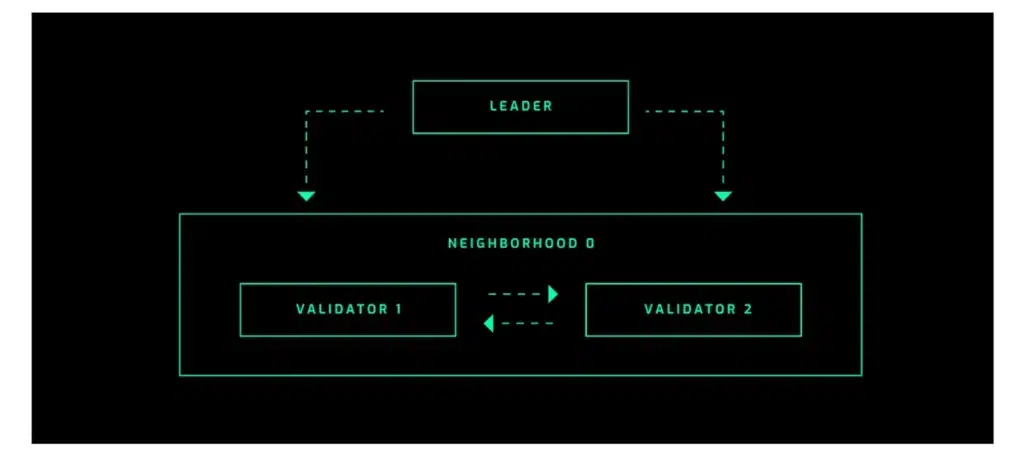
In an interesting take on solana vs ethereum, Brandon Potts of crypto venture capital firm Framework Ventures suggested that the difference between the Ethereum and Solana blockchains is their contrasting strengths.
“Ethereum is going for this bulletproof security model. They are going for more of a settlement layer, more of the high value transactions, if you will. But with Solana, they are going with high speed, low latency, performance and low cost. So I don’t mean to pit those two against one another, but they are starting on opposite ends of the spectrum.”
Gulf Stream
Well, to gain the “mempool-less” transaction forwarding, Solana uses a protocol called Gulf Stream. A mempool is kind of like a waiting area for unprocessed transactions. The validators of a blockchain select transactions from the mempool and later on add them to the network.
Here’s your extensive guide to understanding the concept of mempool and how exactly it works!
In the case of Bitcoin and Ethereum, the number of unprocessed or unconfirmed transactions is somewhere around 20,000-100,000 as shown above and this typically results in significant bottleneck with the mempool rising.
For Solana, every validator knows the order of upcoming block producers and so, the transactions are forwarded to the expected leader ahead of time.
Sealevel
Co-founder of Solana describes Sea Level as, “What we’ve built in Solana is a runtime that can process tens of thousands of contracts in parallel, using as many cores as are available to the Validator.”
Basically, Solana facilitates several smart contracts to operate in parallel and amplifies the computing capacity of its network without negatively affecting the speed of the blockchain.
Pipelining
It is never enough to just form consensus for quick transaction processing. There has to be a way to validate massive blocks of transactions ASAP, while also replicating them across the network at the quickest. For this, the Solana network uses an optimization common in CPU design called pipelining.
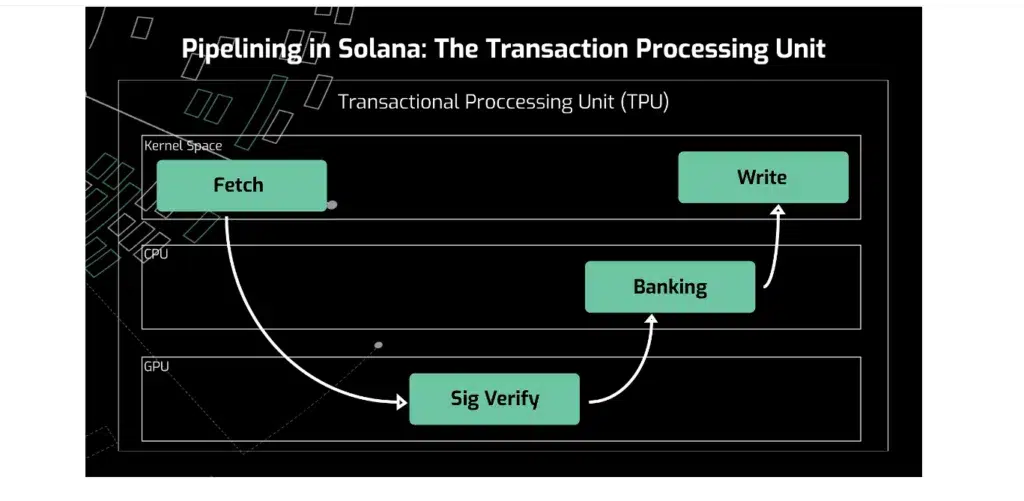
This is a technology in which the input data is required to be processed by a sequence of steps across many hardware devices. So using an analogy for this, we can understand that the washer is stage one, followed by the dryer and the last one is the folding stage.
For maximizing efficiency you will add a third load of laundry to the washer right after the second is in the dryer and the first load is being folded, correct? Putting this analogy to test in Solana, the network ensures that all hardware (the network cards, the CPU cores and the GPU cores) is busy all the time.
Cloudbreak
To understand this concept you need to first have an overview of sharding.
So sharding allows the scaling of a blockchain like Ethereum by splitting the blockchain into smaller “shards.”
Solana uses a horizontally-scaled account database i.e. Cloudbreak which empowers it to write data to and read data from the database for concurrent transactions. This all combines to create Solana the world’s first web scale blockchain. The concurrent reads and writes are possible between the 32 threads through memory-mapped files.
One Last Thing About Solana: SOL Token
A SOL is Solana’s native token can and there are 424,333,409 SOL coins in circulation. SOLs are passed to nodes in a Solana cluster (set of validators) in exchange for running an on-chain program. It is currently ranked among the top 10 cryptocurrencies by market capitalization of $26,838,550,394.
SOL works like a utility token for settling transaction fees and is used for Solana’s staking economy.
So having explored Solana’s technical aspects let’s now delve into the detailed breakdown of Ethereum Blockchain for highlighting the key differences in the showdown between Solana vs Ethereum.
The Detailed Breakdown of Ethereum Blockchain
Vitalik Buterin co-created the Ethereum blockchain project to tackle Bitcoin’s shortcomings. The Ethereum white paper, published in 2013, outlines the vision for the platform which seems to be enabling more than just digital currency transactions.
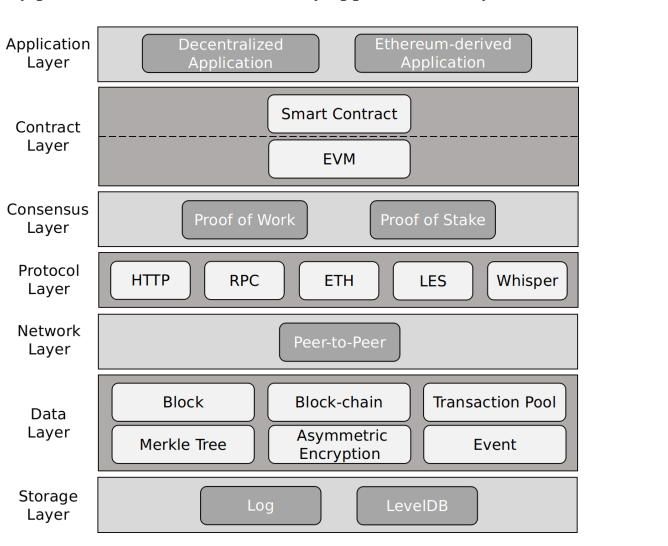
Ethereum introduced the smart contracts — automated immutable “if-then” statements — enabling the development of decentralized applications. Prior to Ethereum, DApp development already existed in the blockchain space but the platforms weren’t interoperable. Buterin believed that unifying the way DApps run and interact was crucial for adoption.
Let us now review what features make up Ethereum blockchain and explore what it offers for this comparison to balance between solana vs ethereum.
Consensus Mechanism
Ethereum blockchain reaches consensus using the proof-of-stake (PoS) algo wherein the validators create news blocks and work together to verify the information these blocks contain. So unlike Bitcoin Ethereum does not rely on Proof of Work for consensus as the original whitepaper proposed a variant called “Ethereum Casper” and now is replaced by PoS that secures the network by requiring validators to stake ETH tokens.
So talking about the comparison in this battle of Solana vs Ethereum, the former uses PoH mechanism to validate information.
Nodes and Clients
Ethereum is a decentralized network and so it is obvious that it uses a network of computers called nodes. This network of computers maintain a copy of the blockchain ledger and plays an incredible role in verifying transactions and network security.
Nodes perform tasks like validation, participate in consensus mechanism, store varying amounts of blockchain data and the like.
According to the Ethereum whitepaper nodes are of three main types:
Full Nodes
Full nodes store the blockchain history including all transactions and blocks and you know this allows them to independently verify transacctions and contribute to network security. In an ideal world, running a full node is possible for those who want to be fully independent validators.
Light Nodes
Light nodes offer a more lightweight alternative to the above as they verify transactions by checking block headers which are as we know much smaller than the entire block data. It is needless to say that this is what makes them more efficient in terms of say storage and processing power.
Well, talking more about light nodes it is noteworthy to mention that they cannot participate in consensus processes as they do not posses the entire blockchain history.
Archive Nodes
These nodes are basically the history buffs you know because these nodes are like full nodes with an extra archival function. So they store not only the current blockchain state but also historical data which can be in turn beneficial for research and analysis purposes.
Now, we are going to discuss clients–which are the software program installed a particular node that allows it to connect to the network. Clients are responsible for downloading and managing blockchain data, processing transactions and allows users to send and receive transactions along with interacting with decentralized applications (dApps) built on the Ethereum blockchain.
So users like you and me do not directly interact with individual nodes but we use client apps like crypto wallets or dApp interfaces to connect to the Ethereum network.
A node runs two client applications called Exceution Client and Consensus Client. Let’s have a brief explanation of these both.
Execution Client
This type of client processes new transactions on EVM and maintains the current state of network data.
Consensus Client (aka Beacon Node)
On the other hand, these client type utilizes the PoS consensus mechanism to verify information from the execution client and reach network-wide agreement on the validity of the new blocks.
Smart Contracts
These are pieces of code stored on the Ethereum blockchain that can be programmed to execute specific actions automatically when certain conditions are met.
By now the importance of smart contracts has risen to a point that there remains no point in defining these self-executing contracts. These are software programs which are run on individual nodes participating in the network in a language that the Ethereum Virtual machine (EVM) understands.
And then when you deploy a smart contract to the Ethereum blockchain it is uploaded and assigned a unique address so that anyone can interact with this smart contract.
Ethereum Virutal Machine (EVM)
Within the Ethereum architecture EVM acts as a decentralized computer that executes smart contracts on the blockchain. EVM acts like a sandboxed execution environment for smart contracts.
Key Features of EVM include:
- Turing Completeness–which means it can theoretically execute any algorithm or program that can allow a wide range of functionalities for smart contracts.
- Deterministic Execution of smart contracts–which means that for a given input and state the outcome will always be the same on any EVM.
- Isolated Execution as the EVM prevents smart contracts from directly accessing the underlying OS or interfering with other contracts which ultimately helps maintain security and stability.
The EVM does not understand high level programming languages you know and so smart contracts are typically written in languages like Solidity and then compiled into EVM bytecode for deployment on the Ethereum blockchain.
Now talking about the role of EVM in transactions is that each node executes smart contract code on its local EVM once the user interacts with it and since the EVM is deterministic all nodes will drive at the same outcome so you know there’s consistency across the network. And then once a consensus is reached on the outcome the state of the Ethereum blockchain updated.
Ethereum Accounts
Ethereum accounts are basically the entities on the blockchain that can interact with the Ethereum network you know like the foundation for user interaction. There are two main types of accounts on the Ethereum network:
- Externally Owned Accounts (EOAs)
- Contact Accounts
EOAs, secured by private key, are like your bank accounts but obviously for the Ethereum network and user controlled and used to hold ETH, send and receive the cryptocurrency to other accounts and interact with smart contracts.
On the other hand, Contract Accounts are not directly controlled by users but by the code of a smart contract which you know means that they can hold ETH and interact with other smart contracts but their behaviour is dictated by the smart contract code.
One Last Thing About Ethereum: Ether (ETH) Token
ETH is more than just a digital currency at this point it fuels literally the entire Ethereum ecosystem allowing secure transactions to happen and enable dApp development. While Ethereum does not have a maximum supply like Bitcoin there have been proposals to introduce a hard cap on the number of coins issued. As of March 2024, Ethereum coins in circulation is approximately 120.2 million ETH.
The ERC-20 standard provides guidelines for creating tokens with specific functionalities which was proposed in 2015 by Fabian Vogelsteller. Ethereum’s token standards extend beyond ERC-20 to include other variants like ERC-777 for tangible tokens with unique features and ERC-721 for NFTs.
Now, ERC-20 tokens are a popular way to represnt assets on the Ethereum blockchain but you know by default when you approve a contract to spend your tokens it can potentially spend all of them so this is where ERC-20 token allowance comes into play.
During the Ethereum Merge in September 2022 there was a significant shift from PoW to PoS for validating transactions and this made Ethereum the top cryptocurrency in terms of staked value.
Conclusion
We have discussed the two prominent players in the world of blockchain technology and pit them up against each other in terms technical aspects between Solana vs Ethereum. So I have explained in the article that Ethereum champions robust security and an incredibly well established developer ecosystem. Its recent transition to Proof of Stake consensus enhances its eco-friendliness but hey Ethereum is still grappling with scalability issues which leads to high transactions fees and slower processing times.
Solana on the other hand priortizes scalability and obviously clearly boasts blazing fast transactions speeds and minimal fees. Its Proof of History consensus mechanism combined with DPoS allows for high throughput. But then i have to also admit that Solana is a younger platform with a smaller developer community compared to Ethereum.
The Solana vs Ethereum debate is not about a clear wonner but it boils down to your specific needs which also underlines the contantly evolving development of blockchains.
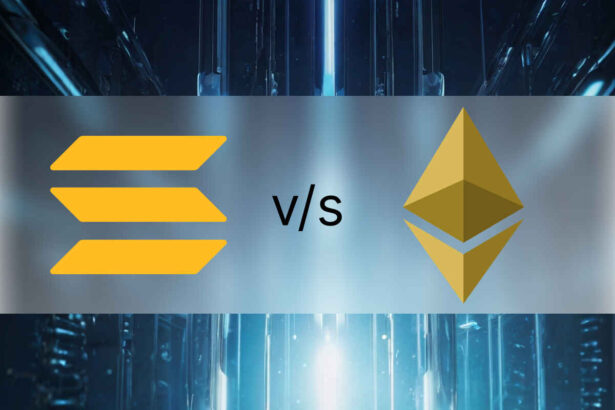


![Zero-Knowledge Large Language Models [zkLLMs]: Revolutionizing Privacy in the AI Ecosystem 7 zkllm](https://droomdroom.com/wp-content/uploads/2024/03/zkllm-150x150.jpeg)













